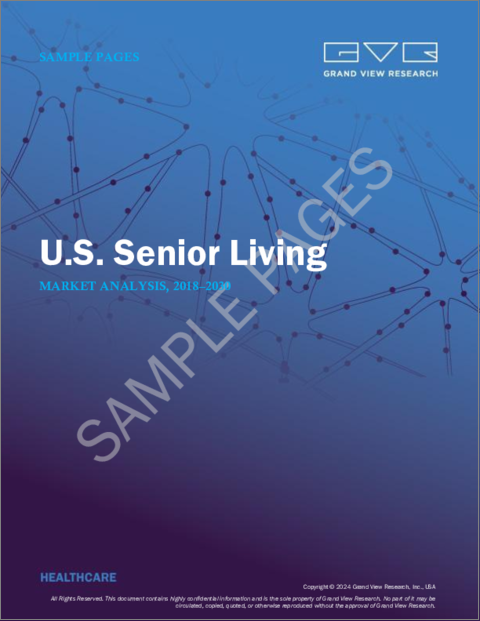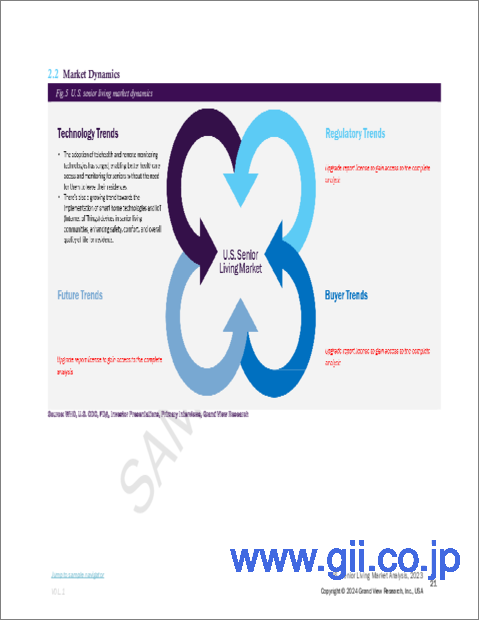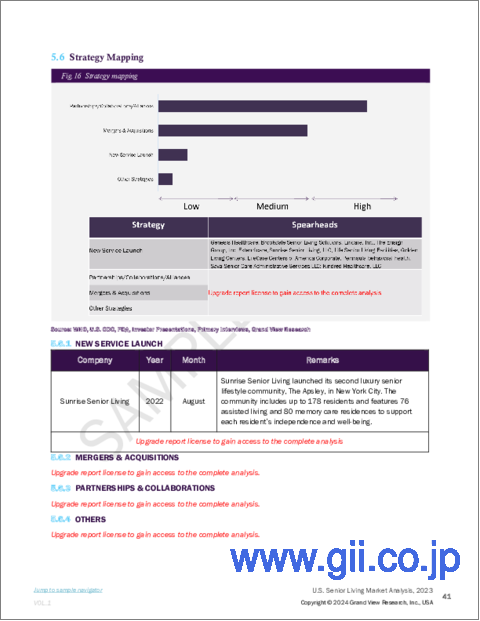|
|
市場調査レポート
商品コード
1530316
米国のシニアリビングの市場規模、シェア、動向分析レポート:施設別、セグメント別予測、2024年~2030年U.S. Senior Living Market Size, Share & Trends Analysis Report By Facility (Skilled Nursing Facility, Assisted Living Facility, Active Adult (55+) Communities/Independent Living, Memory Care) And Segment Forecasts, 2024 - 2030 |
||||||
カスタマイズ可能
|
|||||||
| 米国のシニアリビングの市場規模、シェア、動向分析レポート:施設別、セグメント別予測、2024年~2030年 |
|
出版日: 2024年07月18日
発行: Grand View Research
ページ情報: 英文 90 Pages
納期: 2~10営業日
|
- 全表示
- 概要
- 図表
- 目次
米国のシニアリビングの市場規模・動向
米国のシニアリビングの市場規模は2023年に9,232億米ドルと推計され、高齢者人口の増加により2024年から2030年にかけてCAGR 4.16%で成長すると予測されています。現在、米国には65歳以上の成人が約6,200万人居住しており、人口の18%を占めています。2054年には、65歳以上の成人が8,400万人に達し、人口の23%を占めると予測されています。平均寿命が延び、ベビーブーマー世代が高齢化するにつれ、独立型から介護付き、メモリーケア施設まで、さまざまなタイプのシニアリビングに対する需要が高まっています。この人口動態の変化が、質の高いケアと生活アメニティの提供に重点を置いたシニアリビングの拡大を後押ししています。さらに、こうした施設内に高度なヘルスケア・サービスを統合することで、高齢者が包括的な医療・健康サポートを利用できるようになり、市場の成長を促進しています。
家族構成の進化により、シニアライフのシナリオは年々変化しています。共働き世帯が増え、多世代が暮らす家が少なくなったことで、家族は高齢者のために専門的なケアソリューションを求めるようになっています。この変化により、高齢者に安全で協力的で魅力的な環境を提供するシニア・リビングへの信頼が高まっています。ギャラップ社によると、平均退職年齢は1991年の57歳から2022年には61歳に上昇します。また、非定年退職者の間では、退職予定年齢は1995年の60歳から2022年には66歳に上昇しています。従来の家族による介護が難しくなるにつれ、専門的に管理されたシニアリビングへの需要が高まっています。ヘルスケア、社会活動、介護を融合させた施設は、包括的なソリューションを求める家族にとって特に魅力的です。
ヘルスケアの進歩は、シニアリビング市場に著しい影響を与えています。治療法や技術の向上により寿命が延び、高齢者人口の増加につながった。こうした進歩はまた、高齢者がより健康的な生活を送ることを意味し、医療ケアやウェルネス・プログラムを提供する独立型・介護付き生活施設への需要を高めています。さらに、遠隔医療や遠隔モニタリングが高齢者向け共同住宅に統合されることで、ケアの質が向上し、高齢者やその家族にとって魅力的な選択肢となっています。
さらに、サービスユニットやベッド数のかなりの部分が看護ケアに充てられており、熟練した看護専門スタッフが常駐しています。これらの施設では、看護ケア、24時間体制での監視、毎日3食の食事、日常生活の支援など、必要不可欠なサービスが提供されます。さらに、理学療法、作業療法、言語療法、その他さまざまなリハビリテーション・サービスも提供しています。
さらに、シニアリビング市場のダイナミクスには、経済的な配慮が重要な役割を果たしています。所得水準、住居費、ヘルスケア費用などの要因に影響されるシニアリビングの選択肢の手頃さは、消費者の選択に影響を与えます。多くの高齢者は、生活費を社会保障、年金、個人の貯蓄の組み合わせに頼っています。景気の悪化は、高齢者が個人負担のシニアリビングを購入する能力に影響を与える可能性があり、その結果、政府からの補助金や低コストの代替施設への需要が高まる。逆に、経済の繁栄は可処分所得を増やし、高級なシニアリビングに投資する能力を高めることで、市場の成長を後押しする可能性があります。
目次
第1章 調査手法と範囲
第2章 エグゼクティブサマリー
第3章 米国のシニアリビング市場の変数、動向、範囲
- 市場系統の見通し
- 親市場の見通し
- 関連/付随市場の見通し
- 市場力学
- 市場 促進要因分析
- 市場抑制要因分析
- 米国のシニアリビング市場分析ツール
- ポーターのファイブフォース分析
- PESTEL分析
第4章 米国のシニアリビング市場:施設別推定・動向分析
- セグメントダッシュボード
- 米国のシニアリビング市場:施設変動分析
- 米国のシニアリビング市場施設別展望
- 高度看護施設
- 介護付き住宅
- アクティブシニア(55歳以上)コミュニティ/自立生活
- メモリーケア
第5章 米国のシニアリビング市場:地域別推定・動向分析
- 地域別ダッシュボード
- 米国のシニアリビング市場地域変動分析
- 南東部
- 南東部シニアリビング市場推計・予測、2018年-2030年
- 西部
- 西部シニアリビング市場推計・予測、2018年-2030年
- 中西部
- 中西部シニアリビング市場推計・予測、2018年-2030年
- 北東部
- 北東部シニアリビング市場推計・予測、2018年-2030年
- 南西部
- 南西部シニアリビング市場推計・予測、2018年-2030年
第6章 競合情勢
- 企業分類
- 企業の市況分析
- 主要企業プロファイル
- Genesis Healthcare
- Brookdale Senior Living Solutions
- Lincare, Inc.
- The Ensign Group, Inc
- Sunrise Senior Living, LLC
- Life Senior Living Facilities
- Golden Living Centers
- Sava Senior Care Administrative Services LLC
- LifeCare Centers of America Corporate
- Peninsula behavioral health
- Kindred Healthcare, LLC
- Atria Senior Living, Inc.
- Five Star Senior Living
- Capital Senior Living
- Merrill Gardens
- Integral Senior Living(ISL)
- Belmont Village, LP
- The Villages
- Pultegroup, Inc.
- Latitude Margaritaville
- Hot Springs Village
- Rossmoor Walnut Creek
- Robson Ranch
- Sun Lakes
- Green Valley
- Life Care Services
- Erickson Living
- Kensington Park Senior Living
- Masonicare
- ProMedica Health System, Inc.
- Azura Memory Care
- Affinity Living Group
List of Tables
- Table 1 List of Secondary Sources
- Table 2 List of Abbreviations
- Table 3 U.S. senior living market, by facility, 2018 - 2030 (USD Million)
- Table 4 U.S. senior living market, by region, 2018 - 2030 (USD Million)
List of Figures
- Fig. 1 Information procurement
- Fig. 2 Primary research pattern
- Fig. 3 Market research approaches
- Fig. 4 Value chain-based sizing & forecasting
- Fig. 5 Market formulation & validation
- Fig. 6 US senior living market segmentation
- Fig. 7 Market driver analysis (current & future impact)
- Fig. 8 Market restraint analysis (current & future impact)
- Fig. 9 SWOT analysis, by factor (political & legal, economic and technological)
- Fig. 10 Porter's five forces analysis
- Fig. 11 U.S. senior living market, facility outlook key takeaways (USD Billion)
- Fig. 12 U.S. senior living market: facility movement analysis, 2023 & 2030
- Fig. 13 Skilled nursing facility market revenue estimates and forecasts, 2018 - 2030 (USD Billion)
- Fig. 14 Assisted living facility market revenue estimates and forecasts, 2018 - 2030 (USD Billion)
- Fig. 15 Active adult (55+) communities/independent living market revenue estimates and forecasts, 2018 - 2030 (USD Billion)
- Fig. 16 Memory care market revenue estimates and forecasts, 2018 - 2030 (USD Billion)
- Fig. 17 U.S. senior living market, Region outlook key takeaways (USD Billion)
- Fig. 18 U.S. senior living market: Region movement analysis, 2023 & 2030
- Fig. 19 Southeast market revenue estimates and forecasts, 2018 - 2030 (USD Billion)
- Fig. 20 West market revenue estimates and forecasts, 2018 - 2030 (USD Billion)
- Fig. 21 Midwest market revenue estimates and forecasts, 2018 - 2030 (USD Billion)
- Fig. 22 Northeast market revenue estimates and forecasts, 2018 - 2030 (USD Billion)
- Fig. 23 Southwest market revenue estimates and forecasts, 2018 - 2030 (USD Billion)
- Fig. 24 Company categorization
- Fig. 25 Company market position analysis
- Fig. 26 Strategy mapping
U.S. Senior Living Market Size & Trends
The U.S. senior living market size was estimated at USD 923.20 billion in 2023 and is projected to grow at a CAGR of 4.16% from 2024 to 2030, due to the increasing elderly population. Currently, approximately 62 million adults aged 65 and older reside in the U.S., constituting 18% of the population. By 2054, projections suggest that 84 million adults aged 65 and older will comprise an estimated 23% of the population. As life expectancy rises and the baby boomer generation ages, there is a greater demand for various types of senior housing, ranging from independent living to assisted living and memory care facilities. This demographic shift is driving the expansion of senior living, with an emphasis on providing high-quality care and lifestyle amenities. Furthermore, the integration of advanced healthcare services within these facilities ensures that the aging population can access comprehensive medical and wellness support, fostering market growth.
Senior living scenario has changed over the years due to the evolution of family structures. With more dual-income households and fewer multi-generational homes, families are increasingly seeking professional care solutions for their elderly members. This shift is leading to a higher reliance on senior living to provide safe, supportive, and engaging environments for seniors. According to Gallup, the average retirement age increased from 57 in 1991 to 61 in 2022. Additionally, among non-retirees, the anticipated age of retirement has climbed from 60 in 1995 to 66 in 2022. As traditional family caregiving becomes less feasible, the demand for professionally managed senior living options is growing. Facilities that offer a blend of healthcare, social activities, and personal care are particularly appealing to families looking for comprehensive solutions.
Advancements in healthcare have markedly influenced the senior living market. Improved medical treatments and technologies have extended life expectancy, leading to a larger elderly population. These advancements also mean that seniors are living healthier lives, increasing the demand for independent and assisted living facilities that offer medical care and wellness programs. Moreover, the integration of telemedicine and remote monitoring in senior living communities enhances the quality of care, making these options more attractive to seniors and their families.
Additionally, a substantial portion of service units or beds is dedicated to nursing care, staffed by skilled nursing professionals. These facilities provide essential services such as nursing care, 24-hour supervision, three meals daily, and assistance with daily activities. Additionally, they offer physical, occupational, and speech therapy, along with various other rehabilitation services.
Furthermore, economic considerations play a crucial role in the dynamics of the senior living market. The affordability of senior living options, influenced by factors such as income levels, housing costs, and healthcare expenses, affects consumer choices. Many seniors rely on a combination of Social Security, pensions, and personal savings to cover living costs. Economic downturns can impact the ability of seniors to afford private-pay senior living options, thereby increasing the demand for government-subsidized or lower-cost alternatives. Conversely, economic prosperity can boost market growth by increasing disposable incomes and the ability to invest in premium senior living arrangements.
U.S. Senior Living Facilities Market Report Segmentation
This report forecasts revenue growth at country levels and provides an analysis on the latest industry trends and opportunities in each of the sub-segments from 2018 to 2030. For the purpose of this study, Grand View Research has segmented the U.S. senior living market report based on facility.
- Facility Outlook (Revenue, USD Billion; 2018 - 2030)
- Skilled Nursing Facility
- Assisted Living Facility
- Active Adult (55+) Communities/Independent Living
- Memory Care
- Regional Outlook (Revenue, USD Billion; 2018 - 2030)
- Southeast
- West
- Midwest
- Northeast
- Southwest
Table of Contents
Chapter 1. Methodology and Scope
- 1.1. Market Segmentation and Scope
- 1.1.1. Segment Definitions
- 1.1.1.1. Facility
- 1.1.1.2. Regions
- 1.1.2. Estimates and forecasts timeline
- 1.1.1. Segment Definitions
- 1.2. Research Methodology
- 1.3. Information Procurement
- 1.3.1. Purchased database
- 1.3.2. GVR's internal database
- 1.3.3. Secondary sources
- 1.3.4. Primary research
- 1.3.5. Details of primary research
- 1.4. Information or Data Analysis
- 1.4.1. Data analysis models
- 1.5. Market Formulation & Validation
- 1.6. Model Details
- 1.7. List of Secondary Sources
- 1.8. List of Primary Sources
- 1.9. Objectives
Chapter 2. Executive Summary
- 2.1. Market Outlook
- 2.2. Segment Outlook
- 2.3. Competitive Insights
Chapter 3. U.S. Senior Living Market Variables, Trends & Scope
- 3.1. Market Lineage Outlook
- 3.1.1. Parent Market Outlook
- 3.1.2. Related/ancillary market outlook
- 3.2. Market Dynamics
- 3.2.1. Market Driver Analysis
- 3.2.2. Market Restraint Analysis
- 3.3. U.S. Senior Living Market Analysis Tools
- 3.3.1. Porter's Five Forces Analysis
- 3.3.1.1. Bargaining power of suppliers
- 3.3.1.2. Bargaining power of buyers
- 3.3.1.3. Threat of substitutes
- 3.3.1.4. Threat of new entrants
- 3.3.1.5. Competitive rivalry
- 3.3.2. PESTEL Analysis
- 3.3.2.1. Political landscape
- 3.3.2.2. Economic landscape
- 3.3.2.3. Social landscape
- 3.3.2.4. Technological landscape
- 3.3.2.5. Environmental landscape
- 3.3.2.6. Legal landscape
- 3.3.1. Porter's Five Forces Analysis
Chapter 4. U.S. Senior Living Market: Facility Estimates & Trend Analysis
- 4.1. Segment Dashboard
- 4.2. U.S. Senior Living Market: Facility Movement Analysis
- 4.3. U.S. Senior Living Market by Facility Outlook (USD Billion)
- 4.4. Skilled Nursing Facility
- 4.4.1. Skilled Nursing Facility Market Revenue Estimates and Forecasts, 2018 - 2030 (USD Million)
- 4.5. Assisted Living Facility
- 4.5.1. Assisted Living Facility Market Revenue Estimates and Forecasts, 2018 - 2030 (USD Million)
- 4.6. Active Adult (55+) Communities/Independent Living
- 4.6.1. Active Adult (55+) Communities/Independent Living Market Revenue Estimates and Forecasts, 2018 - 2030 (USD Million)
- 4.7. Memory Care
- 4.7.1. Memory Care Market Revenue Estimates and Forecasts, 2018 - 2030 (USD Million)
Chapter 5. U.S. Senior Living Market: Regional Estimates & Trend Analysis
- 5.1. Regional Dashboard
- 5.2. U.S. Senior Living Market Region Movement Analysis
- 5.3. Southeast
- 5.3.1. Southeast Senior Living Market Estimates and Forecasts, 2018 - 2030 (USD Million)
- 5.4. West
- 5.4.1. West Senior Living Market Estimates and Forecasts, 2018 - 2030 (USD Million)
- 5.5. Midwest
- 5.5.1. Midwest Senior Living Market Estimates and Forecasts, 2018 - 2030 (USD Million)
- 5.6. Northeast
- 5.6.1. Northeast Senior Living Market Estimates and Forecasts, 2018 - 2030 (USD Million)
- 5.7. Southwest
- 5.7.1. Southwest Senior Living Market Estimates and Forecasts, 2018 - 2030 (USD Million)
Chapter 6. Competitive Landscape
- 6.1. Company Categorization
- 6.2. Company Market Position Analysis
- 6.3. Key Company Profiles
- 6.3.1. Genesis Healthcare
- 6.3.1.1. Company overview
- 6.3.1.2. Financial performance
- 6.3.1.3. Service benchmarking
- 6.3.1.4. Strategic initiatives
- 6.3.2. Brookdale Senior Living Solutions
- 6.3.2.1. Company overview
- 6.3.2.2. Financial performance
- 6.3.2.3. Service benchmarking
- 6.3.2.4. Strategic initiatives
- 6.3.3. Lincare, Inc.
- 6.3.3.1. Company overview
- 6.3.3.2. Financial performance
- 6.3.3.3. Service benchmarking
- 6.3.3.4. Strategic initiatives
- 6.3.4. The Ensign Group, Inc
- 6.3.4.1. Company overview
- 6.3.4.2. Financial performance
- 6.3.4.3. Service benchmarking
- 6.3.4.4. Strategic initiatives
- 6.3.5. Sunrise Senior Living, LLC
- 6.3.5.1. Company overview
- 6.3.5.2. Financial performance
- 6.3.5.3. Service benchmarking
- 6.3.5.4. Strategic initiatives
- 6.3.6. Life Senior Living Facilities
- 6.3.6.1. Company overview
- 6.3.6.2. Financial performance
- 6.3.6.3. Service benchmarking
- 6.3.6.4. Strategic initiatives
- 6.3.7. Golden Living Centers
- 6.3.7.1. Company overview
- 6.3.7.2. Financial performance
- 6.3.7.3. Service benchmarking
- 6.3.7.4. Strategic initiatives
- 6.3.8. Sava Senior Care Administrative Services LLC
- 6.3.8.1. Company overview
- 6.3.8.2. Financial performance
- 6.3.8.3. Service benchmarking
- 6.3.8.4. Strategic initiatives
- 6.3.9. LifeCare Centers of America Corporate
- 6.3.9.1. Company overview
- 6.3.9.2. Financial performance
- 6.3.9.3. Service benchmarking
- 6.3.9.4. Strategic initiatives
- 6.3.10. Peninsula behavioral health
- 6.3.10.1. Company overview
- 6.3.10.2. Financial performance
- 6.3.10.3. Service benchmarking
- 6.3.10.4. Strategic initiatives
- 6.3.11. Kindred Healthcare, LLC
- 6.3.11.1. Company overview
- 6.3.11.2. Financial performance
- 6.3.11.3. Service benchmarking
- 6.3.11.4. Strategic initiatives
- 6.3.12. Atria Senior Living, Inc.
- 6.3.12.1. Company overview
- 6.3.12.2. Financial performance
- 6.3.12.3. Service benchmarking
- 6.3.12.4. Strategic initiatives
- 6.3.13. Five Star Senior Living
- 6.3.13.1. Company overview
- 6.3.13.2. Financial performance
- 6.3.13.3. Service benchmarking
- 6.3.13.4. Strategic initiatives
- 6.3.14. Capital Senior Living
- 6.3.14.1. Company overview
- 6.3.14.2. Financial performance
- 6.3.14.3. Service benchmarking
- 6.3.14.4. Strategic initiatives
- 6.3.15. Merrill Gardens
- 6.3.15.1. Company overview
- 6.3.15.2. Financial performance
- 6.3.15.3. Service benchmarking
- 6.3.15.4. Strategic initiatives
- 6.3.16. Integral Senior Living (ISL)
- 6.3.16.1. Company overview
- 6.3.16.2. Financial performance
- 6.3.16.3. Service benchmarking
- 6.3.16.4. Strategic initiatives
- 6.3.17. Belmont Village, L.P.
- 6.3.17.1. Company overview
- 6.3.17.2. Financial performance
- 6.3.17.3. Service benchmarking
- 6.3.17.4. Strategic initiatives
- 6.3.18. The Villages
- 6.3.18.1. Company overview
- 6.3.18.2. Financial performance
- 6.3.18.3. Service benchmarking
- 6.3.18.4. Strategic initiatives
- 6.3.19. Pultegroup, Inc.
- 6.3.19.1. Company overview
- 6.3.19.2. Financial performance
- 6.3.19.3. Service benchmarking
- 6.3.19.4. Strategic initiatives
- 6.3.20. Latitude Margaritaville
- 6.3.20.1. Company overview
- 6.3.20.2. Financial performance
- 6.3.20.3. Service benchmarking
- 6.3.20.4. Strategic initiatives
- 6.3.21. Hot Springs Village
- 6.3.21.1. Company overview
- 6.3.21.2. Financial performance
- 6.3.21.3. Service benchmarking
- 6.3.21.4. Strategic initiatives
- 6.3.22. Rossmoor Walnut Creek
- 6.3.22.1. Company overview
- 6.3.22.2. Financial performance
- 6.3.22.3. Service benchmarking
- 6.3.22.4. Strategic initiatives
- 6.3.23. Robson Ranch
- 6.3.23.1. Company overview
- 6.3.23.2. Financial performance
- 6.3.23.3. Service benchmarking
- 6.3.23.4. Strategic initiatives
- 6.3.24. Sun Lakes
- 6.3.24.1. Company overview
- 6.3.24.2. Financial performance
- 6.3.24.3. Service benchmarking
- 6.3.24.4. Strategic initiatives
- 6.3.25. Green Valley
- 6.3.25.1. Company overview
- 6.3.25.2. Financial performance
- 6.3.25.3. Service benchmarking
- 6.3.25.4. Strategic initiatives
- 6.3.26. Life Care Services
- 6.3.26.1. Company overview
- 6.3.26.2. Financial performance
- 6.3.26.3. Service benchmarking
- 6.3.26.4. Strategic initiatives
- 6.3.27. Erickson Living
- 6.3.27.1. Company overview
- 6.3.27.2. Financial performance
- 6.3.27.3. Service benchmarking
- 6.3.27.4. Strategic initiatives
- 6.3.28. Kensington Park Senior Living
- 6.3.28.1. Company overview
- 6.3.28.2. Financial performance
- 6.3.28.3. Service benchmarking
- 6.3.28.4. Strategic initiatives
- 6.3.29. Masonicare
- 6.3.29.1. Company overview
- 6.3.29.2. Financial performance
- 6.3.29.3. Service benchmarking
- 6.3.29.4. Strategic initiatives
- 6.3.30. ProMedica Health System, Inc.
- 6.3.30.1. Company overview
- 6.3.30.2. Financial performance
- 6.3.30.3. Service benchmarking
- 6.3.30.4. Strategic initiatives
- 6.3.31. Azura Memory Care
- 6.3.31.1. Company overview
- 6.3.31.2. Financial performance
- 6.3.31.3. Service benchmarking
- 6.3.31.4. Strategic initiatives
- 6.3.32. Affinity Living Group
- 6.3.32.1. Company overview
- 6.3.32.2. Financial performance
- 6.3.32.3. Service benchmarking
- 6.3.32.4. Strategic initiatives
- 6.3.1. Genesis Healthcare






